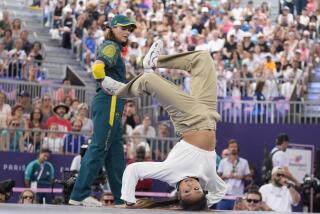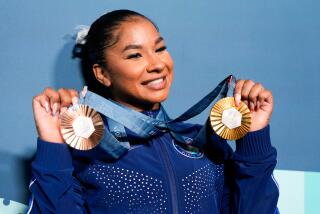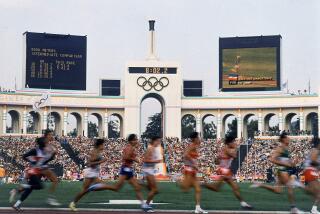Jury Still Out on Judging Proposal
SALT LAKE CITY — Buy stock in asterisks.
Every record book that includes figure skating results in the future is going to be filled with them. Peggy Fleming’s gold medal in 1968? * Dorothy Hamill’s gold medal in 1976? * The Torvill & Dean gold medal in 1984? * Brian Boitano’s gold medal in 1988? * The pairs gold medal in Salt Lake City? **
The gold medal about to be won here in women’s figure skating by Michelle Kwan, Irina Slutskaya, Sasha Cohen or someone else? Yes, still another *.
I’m not saying that skaters winning medals in the last 120 years--the first figure skating competition on record occurred in 1882--didn’t deserve them. If you had a Dorothy Hamill haircut in the ‘70s, you don’t have to feel guilty. Jack in the Box doesn’t have to pull its Brian Boitano ads.
I’m not saying that the woman crowned Olympic champion Thursday night at the Salt Lake Ice Center won’t be the best.
In fact, I’m not saying anything.
It was the International Skating Union, which governs figure skating, that said Monday that its age-old system of determining winners and losers is sometimes corrupt and always corruptible.
In an incredible news conference after a meeting of the 11-member ISU Council, the federation’s president, Ottavio Cinquanta of Italy, all but confessed that the scoring system--nine judges scoring skaters from a range of 0.0 to 6.0 for both technical merit and presentation--is infested with bias. He mentioned bloc voting specifically, suggesting that the old cold warriors never die. They just rig figure skating contests.
*
So what does the ISU do about it?
I’ve heard numerous suggestions for reform in the week since the start of the monster pairs controversy that ate the Salt Lake City Olympics, but none more radical than the one proposed Monday in a unanimous vote by the ISU.
Cinquanta’s news conference produced more questions than answers. But the clear impression he left was that this proposal is a work in progress that will be further debated and defined before a vote of the ISU Congress in June.
The plan, as I understand it, is that future judging panels would be composed of 14 members instead of nine. The scores of only seven of them, randomly selected by a computer, would be counted.
A skater would start his program with zero. Each element he performs would be worth a certain number of points. He would receive bonus points depending on how well he performed the element.
For example, a triple salchow landed might be worth 3 points. If it is done poorly, there might be no bonus. If it is average, it might be worth 1 bonus point. If it is excellent, it might be worth 2 extra points. There would be a similar scoring system for spins, laybacks and footwork in singles and throws and lifts in pairs. (No one would still be able to figure out how ice dancing should be judged.)
The system would not eliminate subjectivity, because it would be up to each judge to determine how well he or she believes an element is performed. But there would be a 50-50 chance of eliminating a biased judge and a 100% chance of eliminating bloc voting because no judge would be able to guarantee his or her scores would count.
At the end of the day, the skater with the most points would win.
Cinquanta suggested that it might create even more interest in the sport because it would create records. For instance, you might see this kind of story from Turin, Italy, in 2006:
“Nailing a quadruple salchow-triple toe-double toe combination with only three seconds remaining in his freestyle program, Timothy Goebel of the United States won the Olympic men’s gold medal Thursday night with a world-record score of 8361/2 points.”
In other words, figure skating would be a sport.
But would it be better?
That is unclear.
One thing separating figure skating from other judged disciplines such as gymnastics, diving and boxing is that beauty counts. In the freestyle programs for singles and pairs, presentation scores--the bottom marks, below the row of technical scores--are the tiebreakers.
Figure skating’s caretakers have decided it should be thus because they want to assure that the athletes--don’t even question the use of that word, because they are great athletes--concentrate as much, maybe even a little more, on the aesthetics of their programs as they do on the tricks.
It has been a difficult balance to maintain. Those who lean toward the technical side of the sport were satisfied in 1992, when Ukrainian high jumper Viktor Petrenko edged American Paul Wylie for the gold medal.
The pendulum, however, had swung back by 1994, when the ballerina-like Oksana Baiul of Ukraine beat Nancy Kerrigan of the United States.
Perhaps that side is too far ahead now. Since her flat, third-place performance in the U.S. championships at Staples Center, Sarah Hughes, until very recently, didn’t feel the necessity to enhance the difficulty of her programs. She has, at the insistence of judges, changed her hairstyle and dresses.
But figure skating should retain its emphasis on art so that it doesn’t become gymnastics on
ice.
Cinquanta didn’t address how, or even if, the ISU proposal might achieve that. He seemed unsure whether presentation would be scored as just another element or as an important element.
But there were a number of things Cinquanta didn’t address.
I would give him a 5.2 for details and a 4.9 for presentation.
*
Randy Harvey can be reached at [email protected].
More to Read
Go beyond the scoreboard
Get the latest on L.A.'s teams in the daily Sports Report newsletter.
You may occasionally receive promotional content from the Los Angeles Times.








